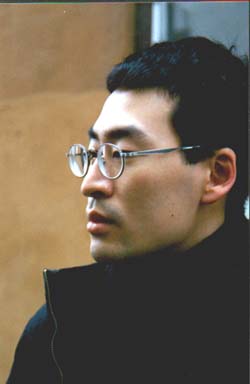Martin Claesson
Jenny C. Milton is a striking contrast to her person in her texts in Zine in Time. Her character doesn't aspire to that straight forward, somewhat fresh attitude she uses in her writing. But still there's something there about her, which I recognize from her texts. I've pictured her red-haired, and tall, intelligent and odd. But that's just Jenny in my own imagination — in reality that's not Jenny at all.
Jenny was born in Stockholm, autumn 1996. Martin Claesson had just started a new e-zine and Jenny was born. "I used the nickname Milton on IRC, so I signed the editorial column with the name Jenny C. Milton. Just Milton was too close to John Milton. But after that some people on IRC thought I was female," says Martin, who in fact is the man behind the woman and editor in chief, Jenny C. Milton.
The zine began simply as an idea to put up things on-line. And that's something typical for it. It doesn't come in issues, instead, new texts, stories and poetry are published every now and then. It's kind of a large issue, with an archive of texts, divided into different categories.
Martin admits Jenny does get mail, addressed to Jenny and not to Martin, but he doesn't drive the illusion as far as to let Jenny write e-mails. "I usually write an reply, signing with my name, but saying I represent Zine in Time. I say that Jenny is out of town, or not available. She's often out of town."
The reason Martin has a fake Editor in Chief, is the same reason he has a fake Web Editor, Art Director, Production Director, and Production Coordinator. Because really Martin is behind all that work. "If you have a magazine you should have an editorial staff," Martin says.
 Today Martin is studying Korean at the university of Stockholm, he does Zine in Time, he does some TV, as a part of Mean Panda (which consists of Martin Claesson and Mikael Dunker) he builds the web gallery Krita, where various artists will be featured on-line. The gallery is produced by the quasi-fictive enterprise, Hexarte. The same enterprise which is the reason to Zine in Time.
Today Martin is studying Korean at the university of Stockholm, he does Zine in Time, he does some TV, as a part of Mean Panda (which consists of Martin Claesson and Mikael Dunker) he builds the web gallery Krita, where various artists will be featured on-line. The gallery is produced by the quasi-fictive enterprise, Hexarte. The same enterprise which is the reason to Zine in Time.
Martin has been on-line since May, 1996. He had bought his first computer in February, 1996, and had just gotten himself an Internet account. That was about the time when net.surfing began becoming more common in Sweden, and Martin nostalgically reveals his first web browser was Netscape 1. I'm not even sure if a majority of the Internet surfers today has ever used Netscape 1. It was only two years ago. "I didn't have any graphics, it was all text based, and I really couldn't do that much," Martin says making it sound like in spite it wasn't that bad, because of what he later says, that the content is important. "Then you could make a homepage with just text, which is worth reading. People could see it was well done, and it didn't have to look, or be, complex."
He doesn't surf the Web that much. Mostly he uses his e-mail. He's been on IRC since he got his account, since he has had it from the start. His interest for photography is based on his interest in video and film. He studied some video in high school, and have studied film science in the university. "But I'm not really interested in photography," Martin says, "it's more of an interest in film."
Though he's writing on-line Martin says he doesn't read any books at all, not any novels. He mostly reads magazines, an that's where he got his interest for on-line publications, e-zines. The Swedish magazine ETC, is the magazine he reads most now.
He doesn't read any fan-zines in print, which are harder to get hold of than e-zines. "If you get hold of someone who knows something about fan-zines they usually know a lot about them," Martin says. "Many people who do e-zines also do fan-zines." I wonder what Jenny would ahve said. Or what she'd have written.
Before we go our separate paths we wonder if it's okay for us to reveal the e-zine illusion now that we know of it. And Martin says it's okay. "Yeah, you can write about it. I'll probably make something new."
 Today Martin is studying Korean at the university of Stockholm, he does Zine in Time, he does some TV, as a part of
Today Martin is studying Korean at the university of Stockholm, he does Zine in Time, he does some TV, as a part of